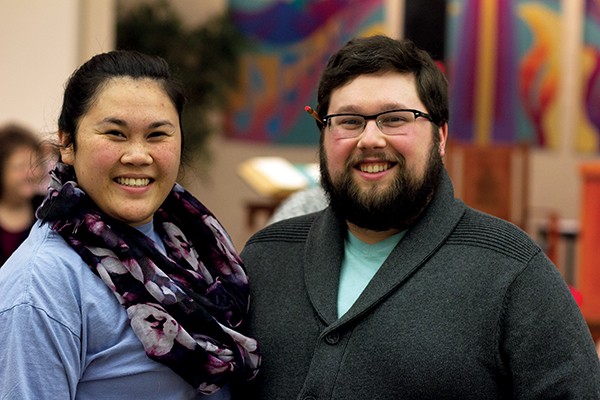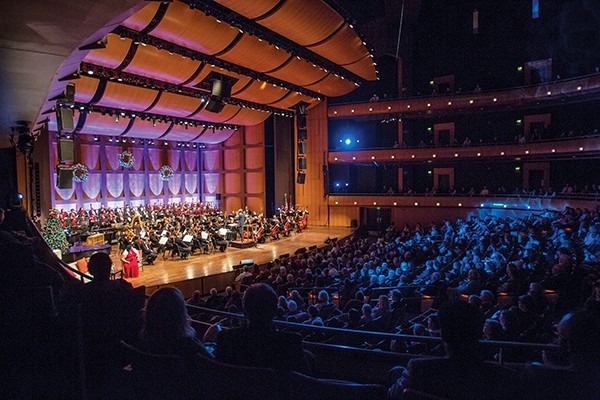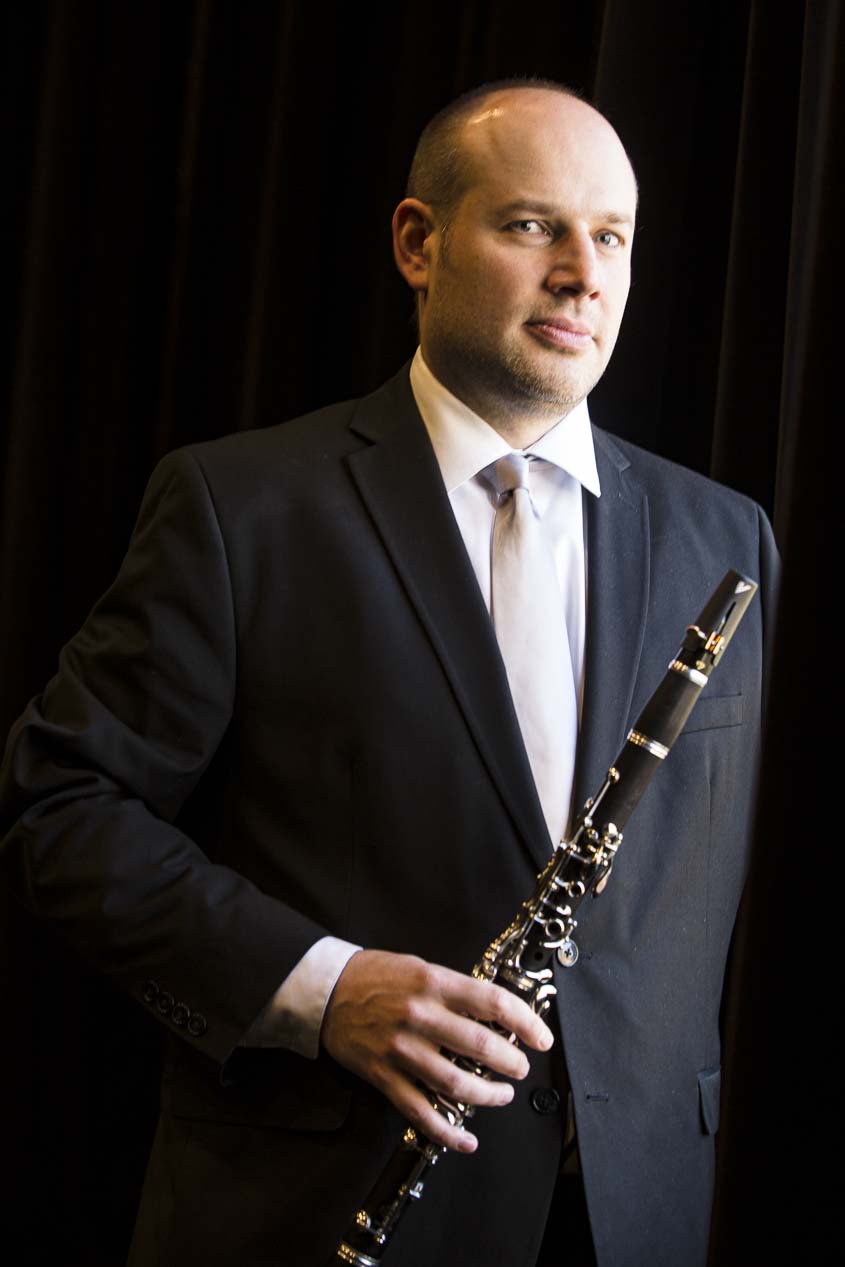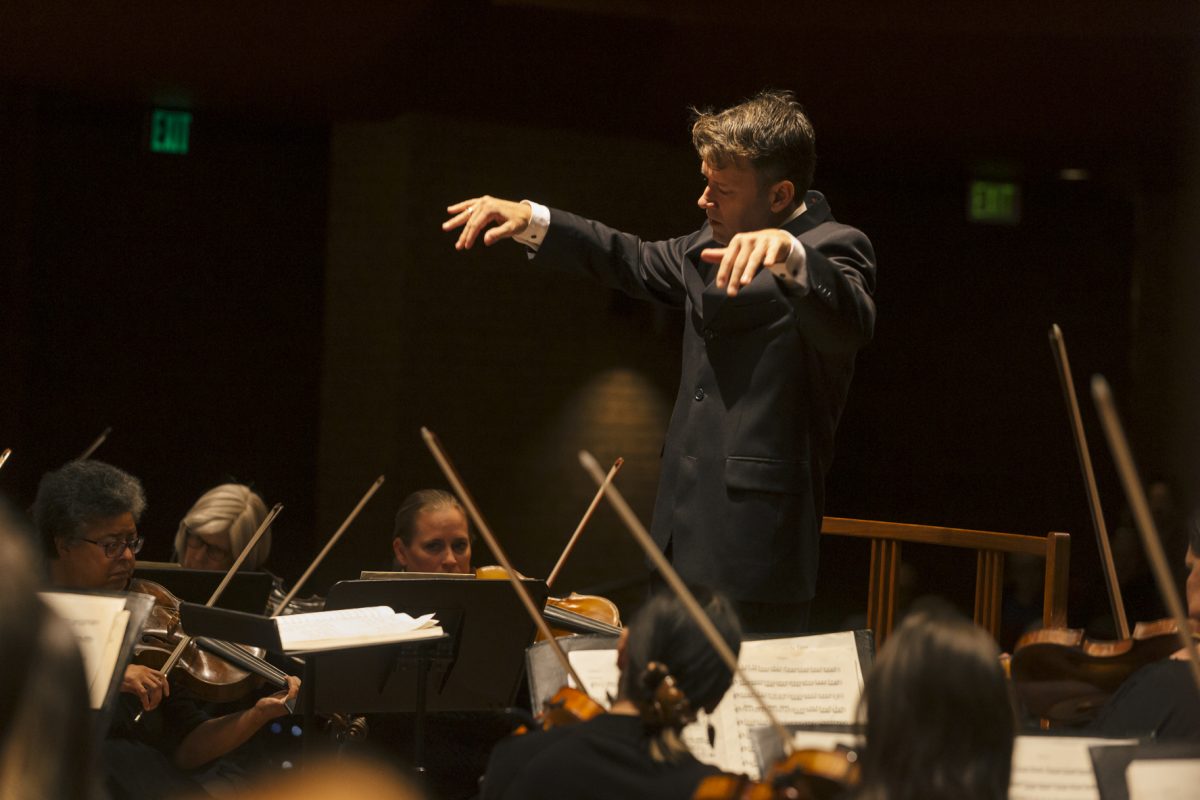From rock-and-roll and soul, to R&B and hip-hop, there’s no doubt Memphis is one of the world’s premier music cities. As Memphis music has conquered the world over the last five decades, there has been a group that has performed in front of untold thousands of people, but who have largely flown under the radar of most Memphians: the Memphis Symphony Chorus.
The musicians who make up the chorus are mostly ordinary people with day jobs, families, and normal worries. But when they line up behind the musicians of the Memphis Symphony Orchestra in the Cannon Center or at Sunset Symphony, they become something greater. “You’ve got 100 people coming together to make something ephemeral and beautiful,” alto Terron Perk says. “It goes back through the centuries. It’s a continuity of humanity and art that is really exciting to be a part of.”
Jan Carnall, a teacher turned full-time artist who has served as the group’s historian for the last few years, says the chorus was started in 1965 to allow the symphony to take on a wider range of musical works. “There was a lot of interest among church choirs to form one large chorus,” she says.
That first year, the chorus had two performances: A Rodgers and Hammerstein medley in the summer, and Leroy Anderson’s “Suite of Carols” at two holiday performances.
Baritone Irvine Cherry is one of the group’s longest-serving members, having joined the chorus 45 years ago. “My wife got me involved. I got roped in. When I started out, we were rehearsing in the choir loft at Second Presbyterian Church.”
For the chorus’ 50th anniversary, Carnall researched the group’s history, compiling hundreds of newspaper clippings, snapshots, and memorabilia into four thick scrapbooks full of headlines like “SYMPHONY, CHORUSES SOAR TO GLORY.”
“I can’t say enough about how important [the chorus] is to the city,” Carnall says.
 Courtesy of Memphis Symphony Orchestra
Courtesy of Memphis Symphony Orchestra
The chorus performs dozens of works every year, but some stick in the singers’ memories, such as the infamous 1996 performance of Beethoven’s Missa somlemnis. “Beethoven’s Mass [in D major] was the toughest thing I’ve ever done,” Cherry says.
“Beethoven is one of my favorite composers,” Carnall says. “But he does not take kindly to voices! He always composes quite difficult pieces. He was very temperamental.”
The Missa solmenis requires sopranos like Carnall to sing at the top of their range for extended periods. “It was quite a monumental piece. It was quite difficult. I almost quit. But I said, you know, I am not a quitter! I can learn from this!” The chorus commemorated the grueling performance with buttons that read “I SURVIVED MISSA SOLMENIS 96″.
For chorus members like Cherry, these are the kinds of challenges that keep them coming back, year after year. “I just enjoy it tremendously,” he says. “I like to sing. That’s what it amounts to.”
The chorus’ founding director was Sara Beth Causey. “She auditioned me when I came to the chorus in the ’70s,” Carnall says. “I remember her as being a very disciplined person. She really expected a lot out of the chorus.”
In 1988, the baton passed to Larry Edwards. “I came to Memphis to be the director of choral activities at the University of Memphis Rudi E. Scheidt school of music,” he says. “At the end of my first year teaching here, I got a call from the executive director asking if I was interested in the Symphony Chorus position, should it ever come open. I came down here as a young faculty member, and committed my career to working in the community of Memphis. I think a big part of my longevity here is due to the Symphony Chorus.”
Edwards’ students often sing alongside the chorus. “I enjoy teaching at the university level. I believe in collaboration in the arts, so both positions here have been really helpful to build up an interesting culture of choral music. Having my young people sing alongside these passionate volunteers is a great thing for my students, and I think it’s a really good thing for the Symphony Chorus to collaborate with this group of really talented singers who come here to learn music.”
“The human voice is the oldest of instruments,” Davis says. “The tradition of getting voices together to sing is a long one, going back hundreds and hundreds of years. It’s my position that most instruments aspire to use the sound of the human voice as their litmus test. Ideas of vibrato, for example, come out of the vocal tradition. I know in the studios here, the instrumental faculty encourage their trumpet players, their violin players, to sing. They’ll sing a line, and then say that’s what we want to have happen to your instrument. I think it’s the foundation of all music-making.”
To lead the chorus, Edwards works closely with Lisa Mendel, who is an associate professor of audiology at the University of Memphis. Mendel first tried out for the chorus in 1990. “I was looking for an outlet for my minimal musical skills at the time. In a few years, I was asked to be on the board. A few years after that, I was asked to be president, and I’ve been president ever since. It’s been a great opportunity.”
Keeping so many volunteers engaged in the demanding task of transforming notes on a page into music takes work, Mendel says. “We consider ourselves a professional chorus, even though we’re not paid. Our payment is the performance — and even the rehearsals. On some performance weeks, we practice every night. It’s quite a sacrifice for busy working people. They are so drawn to the love of singing and the love of performing. There’s so much that brings us together.”
Mendel says meticulous preparation is the key to sustaining a volunteer organization over the long term. “I think having a structure helps a lot. If people come to a rehearsal, and it’s chaotic … the music’s not ready, the conductor is not there … it’s difficult for people. But when you walk through our door, there’s a structure. You know what’s going to happen. You know where things are.”
 Laura Jean Hocking
Laura Jean Hocking
Liz Parsons rehearses the altos
Edwards says the rehearsals at the Balmoral Presbyterian Church at Quince and Kirby are just as important to group cohesion as the performances at the Cannon Center. “The process has to be enjoyable and rewarding. They have to come and leave their stressful jobs and busy lives and focus on doing something totally different and still be challenged and pushed. They get to experience a different side of life. I’ve done this for almost 30 years, and I enjoy watching it change the lives of people who come out every Monday night.”
Chorus members come from all walks of life and represent all levels of musical accomplishment. Alto Kelley Smith has a degree from the Peabody Conservatory of Music, and, since the 1970s, has sang professionally alongside such luminaries as Eartha Kitt on Broadway, and even at Disney World. “You name it, I did it,” she says. “I feel that Dr. Edwards, our music director — when it comes to choral music, they simply don’t get any better. It’s an honor for me to sit under his tutelage every Monday night. He understands what’s written on the page and what isn’t. It takes that kind of musical intelligence to get that over to the singers in order for the music to be done right. I’m forever learning. I never go into it thinking, I got this.”
 Laura Jean Hocking
Laura Jean Hocking
Music teachers Samantha Wilson and Joseph Powell
Samantha Wilson and Joseph Powell are getting married on June 3rd. They are both choir directors; she at Treadwell Middle School, he at White Station High School. “You run the music really quickly, and perform it. I think that’s my favorite part: We go through so much music in a short amount of time,” Wilson says.
“It’s great for people like us, who are musicians as our day job,” Powell says. “It’s great for people who have never done anything like this before who enjoy singing, because it’s a great mix of both worlds. You have the amateurs who just love it, and you have people who take it really seriously, because it’s their thing. To be able to bring that diverse group of people together and achieve a great sound is one of the great things about this group. It’s such a wide range of backgrounds and people.”
Shane Rasner’s day job is as a dentist, but the chorus fills an important need. “I can’t imagine my life without music. It’s a great opportunity to live in a city where they have a symphony and a chorus. The Mozart Requiem we did after 9/11 was very powerful. I’ll never forget that.”
 Laura Jean Hocking
Laura Jean Hocking
50th Anniversary Concert on Friday
The Mozart Requiem, a favorite with both fans and musicians, was also the first piece Cindy Armistead, administrator for Campbell Clinic Surgery Center, performed with the group. “I was just overwhelmed by the talent surrounding me, not just vocally, but the instrumentalists up on the stage. It was incredible,” she recalls. “I am not the prepared musician most of these people are. I was a science major. My brother was a member of the chorus, and he told me I should audition. I’ve never auditioned for anything in my life! It was quite the eye-opener for me. It was intimidating initially, but everyone is so open and so into teaching. We all want to do our best. I look forward to coming, just to learn.”
Jennie Latta, a bankruptcy judge and mother of six, has sung with the chorus for 11 years. “I don’t like to watch football or baseball. I like to play,” she says. “It’s the same with music. I love to go to concerts, but I would much rather be involved in it myself.”
Latta says the diversity of musical experience keeps her coming back. “When we celebrated our 40th anniversary, we did a big show at First Congo. We ringed the room, and sang an a cappella piece, and it was astonishing. The idea that that many people could sing together separated by that much space is awesome. It was one of the most amazing things I’ve ever done. Singing with church choirs, you don’t get to push the envelope.”
Dr. Edwards and the Symphony’s staff and conductors sometimes plan out a season’s music as much as 18 months in advance. But then the two groups go their separate ways. “They forget about us,” he says, until the final rehearsals about a week before a performance, when he turns the chorus over to the conductor. “At 7:30, there’s a trained chorus on the stage ready to merge with a group of professional instrumentalists.”
Mendel says, “I think what’s interesting is that many of the performances that we do, we’re performing under a different conductor. So one of Larry’s many skills is teaching us music from not only from a musicality standpoint, but he also teaches us to be flexible, so when we get with a different conductor who might take a phrase differently from what Larry has taught us, we can change quickly and work with him. Singing in different genres, singing with different conductors, singing in different venues just add to the versatility and flexibility of our group.”
“People ask what it’s like to work so hard on a piece of music, and put your heart and soul into the preparation of it, and then I sit in the balcony. I turn the performance over to someone else,” Edwards says. “Sometimes I don’t breathe, but my reward is at the end of the piece: seeing the faces of the chorus and hearing the cheers of the audience.”
For the last three years, Edwards has turned his chorus over to MSO conductor Mei-Ann Chen. “She’s a very demanding artist,” he says. “But in our 50th anniversary season, she worked really hard to highlight the chorus.”
“[Chen] is a fantastic musician,” Perk says. “She is also a cat wrangler who knows how to get the best out of her musicians. The chorus would go over a cliff for Mei-Ann Chen.”
Chen says the feeling is mutual. “These are some of the best people in Memphis. I really treasure what we have done together onstage. I will always remember the incredible trust we placed in each other. When I was coming in new, they embraced me.”
During the Memphis Symphony’s recent financial crisis, Chen says she was moved that one of our chorus members contributed $100,000. “That’s a story you don’t hear often,” she says. “The dedication and appreciation between the two organizations.”
The chorus holds auditions for new members in August and January. Mary Seratt, a retired library administrator who has sung with the chorus for over 20 years, recalls how she got up the nerve to try out. “I was facing some medical tests. The outcome could have been pretty crummy, so I did things like … I rode roller coasters. I’d always wanted to sing with this bunch, because I’m a symphony supporter. I thought, what’s the worst that could happen? I’m going to die. I should try out. And I made it. And lo and behold, I didn’t die!”
 Courtesy of Memphis Symphony Orchestra
Courtesy of Memphis Symphony Orchestra
Full symphony, chorus, and audience from the Holiday Pops show
For those who are considering auditioning, Seratt says “Do it. Swallow your fear. But be prepared — you’re going to have to sight read. You might have a lovely voice, and your mommy thinks you’re a great singer, but if you’re semi-professional, can read music, take direction, and work well with others, come with us.”
On February 5th, the Memphis Symphony Chorus will celebrate its 50th anniversary. “We’re doing this concert in the Immaculate Conception cathedral. What a treasure they are to the artistic community here in Memphis,” Edwards says. “They have an open arms policy in allowing their space to be used for artistic events, and they have been just amazing. I’ve chosen literature that will work especially well in this space. There’s a three-second reverb in there! We call it a stand-alone concert. It’s going to be mostly a cappella.
“It’s an opportunity to work with the chorus on a different level of finesse than when we’re working with the orchestra. I think the Symphony Chorus is growing into a chorus that is comfortable working both with or without the orchestra. That’s been an exciting journey that we’ve taken, and it’s been an exciting journey for the symphony audience. That’s our benchmark. It’s not that we sometimes do a great job. It’s that we always do a great job.”


 Courtesy of Memphis Symphony Orchestra
Courtesy of Memphis Symphony Orchestra  Laura Jean Hocking
Laura Jean Hocking  Laura Jean Hocking
Laura Jean Hocking  Laura Jean Hocking
Laura Jean Hocking  Courtesy of Memphis Symphony Orchestra
Courtesy of Memphis Symphony Orchestra